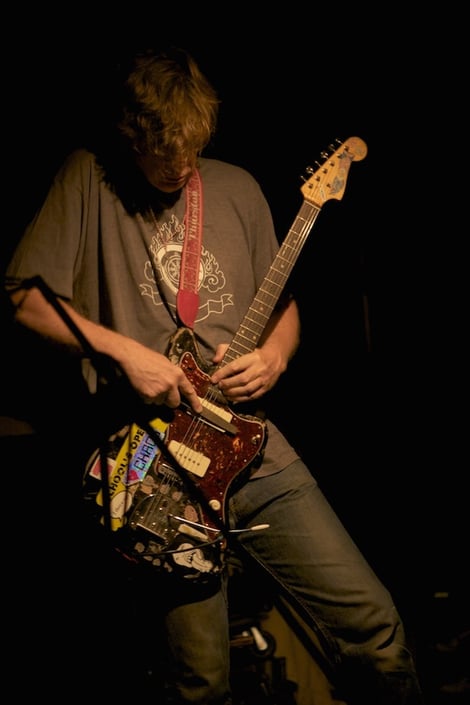
Photo by Alan Bee via Flickr / CC BY 2.0
Being the tone nerds we are, guitarists are always looking for ways to get new and interesting sounds out of our instruments. Usually, this quest ends in a trip to the music store to buy some new effects pedals, as well as a significant drop in our bank balance. But what if there were ways you could expand your sound palette without expanding your pedalboard? If you’re on a never-ending quest for new sounds, here are a few ideas that won’t cost too much and will stretch your imagination further than any new pedal would.
1. Ditch the pick
The most obvious place to change up your guitar’s sound is the initial point of contact. Whether you’re playing electric or acoustic, the way in which you attack the strings and the material you use to do so plays a huge role in your guitar’s overall tone. Using picks made from different materials like bone, graphite, or even copper can make a big difference in the way your guitar sounds. Or if you’re feeling especially experimental, you could always ditch the pick altogether and find another object like a drumstick or screwdriver to attack your strings with. Thurston Moore and Lee Ranaldo of Sonic Youth were the masters of this technique, but other guitarists like Jimmy Page, Jonsi of Sigur Ros, and Wilco’s Nels Cline have also had great success in finding odd and interesting objects to play their guitars with.
2. Ditch the amp
Guitarists can compare different amp tones for days on end, but if you want something really different, try ditching the amp altogether. This is exactly what Will Weisenfeld of Baths did when recording the song "Plea." By sticking a microphone in front of an electric guitar and playing it like an acoustic, he created the sitar-like sound you hear throughout the song.
3. Expand your capo vocabulary
For some guitarists, "capo" is a dirty word, but what many people don’t realize is that capos aren’t just meant to be used as lazy transposition tools; they’re also great tools for expanding your tonal range.
A simple and effective way to use capos in this sense is to layer rhythm guitar parts playing the same passage in different positions on the neck, using a capo to achieve different chord voicings. Another way to use capos to create new sounds is to experiment with using partial capos or using several capos at once to cover different strings. This will give you a similar sound to what you might achieve with open tunings, without the disadvantages of having to re-tune or deal with loose and dull sounding strings. Fingerstyle guitarist Harvey Reid was one of the first players to popularize the use of partial capos, and guitarists in many genres have now adopted his capo techniques to create their own unique tunings and chord voicings.
4. Work in fragments
With six strings at their disposal, guitarists are excellent multitaskers. But just because you can play six notes at once, that doesn’t mean you always should. If you play in a band with multiple guitarists, or if you have the power of overdubbing at your disposal, you can alter your sound by separating parts out into multiple layers. For example, instead of playing a triad on three strings with a single strum, separate the triad into three distinct tracks with each guitar playing one note in the triad. Avant-garde classical composer Rhys Chatham used this technique to great effect with compositions like "A Crimson Grail" and "An Angel Moves Too Fast to See," which are scored for hundreds of electric guitars. With each section of guitars playing one note at a time, he creates lush, ambient chords full of rich overtones that give the impression of strings or human voices rather than guitars.
5. Sample your own instrument
If you have access to digital recording equipment, as many DIY musicians do these days, you have the ability to endlessly modify your guitar sound using plugins and other forms of digital manipulations. Most of these digital tools are designed to do a similar job to what guitar pedals do, but there’s always the option of going a completely different direction. Instead of always thinking like a guitar player, try thinking like an electronic musician when you approach your guitar tracks in the digital realm. Any DAW gives you the option to chop up sounds, move things around, slow things down, speed things up, and otherwise destroy/improve your existing recording. Electronic artist Tim Hecker took this technique to the extreme with his album My Love Is Rotten to the Core, which is composed almost entirely of samples from Eddie Van Halen’s guitar solos (but which really sounds nothing at all like Van Halen).
One of the best things about being a guitar player is you have almost no limitations in terms of the sounds you can create. All it takes is some imagination and a little experimentation to come up with new and interesting sounds. These techniques are just a start – as long as you’re not worried about always playing the guitar "properly," the possibilities for innovation really are endless.
Casey van Wensem is a freelance composer, musician, and writer living in Kelowna, B.C., Canada. You can hear his musical work at birdscompanionmusic.com and read his written work at caseyvanwensemwriting.com.







